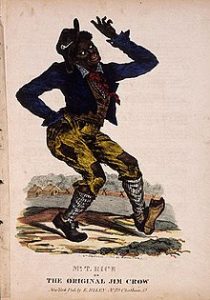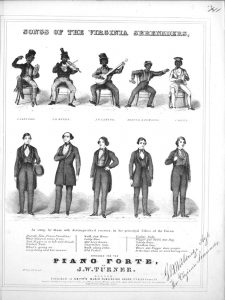As long as the entertainment industry has sought to reach the masses it has caused controversy. Minstrel shows, the first form of mass entertainment in the United States,1 is one of the most prolific examples of this. Minstrelsy relied heavily on songs and dances performed in blackface, the act of covering one’s face in burnt cork to give the illusion that the actor or actress is black themselves. Characters that were in blackface were played as caricatures of stereotypes in the African American community.
These performances not only relied on racist notions of identity but also gendered ones. White male performers could experiment with identity and commodify it by playing on the entertainment quality of challenging racial and gendered notions of identity.2 Thomas Rice, the actor who created the Jim Crow character, is one example of these performers.3 The Jim Crow character was modeled as a former slave who wished to return to the way things had been during the antebellum years. During and after reconstruction real, living, breathing black American men lived in fear and persecution due to racist beliefs that created a scary and wild image of them. Minstrel shows furthered these images by showcasing them as stupid and brutish. The Jim Crow character was an emasculating and oftentimes pitiful version of the African American man.4 This portrayal stood as a stark contrast from the expectations of white men during this time period. A poster from a five person minstrel show shows this contrast. In it you can see through their difference in posture, clothing, and personality the inferiority of their African American characters.
Jokes at the expense of the African American men were the real cherry on top. For example, the Jim Crow character’s wish to return to plantation life also included his desire for the protection of his master. This falsely portrayed wish for domination says more about white men than it does about their black counterparts. It exhibits the racist and sexist values of the United States and the too slow change in societal acceptance. Minstrelsy was a popular and important part of the American entertainment industry. Like many forms of entertainment, though, it helped to fuel the fire of hate a prejudice and that cannot be forgotten.
1 Weiner, Melissa F. “Minstrelsy.” In The American Mosaic: The African American Experience, ABC-CLIO, 2018.
2 Locke, Joseph. “Blackface.” In The American Mosaic: The African American Experience, ABC-CLIO, 2018.
3 Burns, James. “Thomas Rice.” In The American Mosaic: The African American Experience, ABC-CLIO, 2018.
4 Nuruddin, Yusuf. “Jim Crow Racial Stereotypes.” In The American Mosaic: The African American Experience, ABC-CLIO, 2018.


